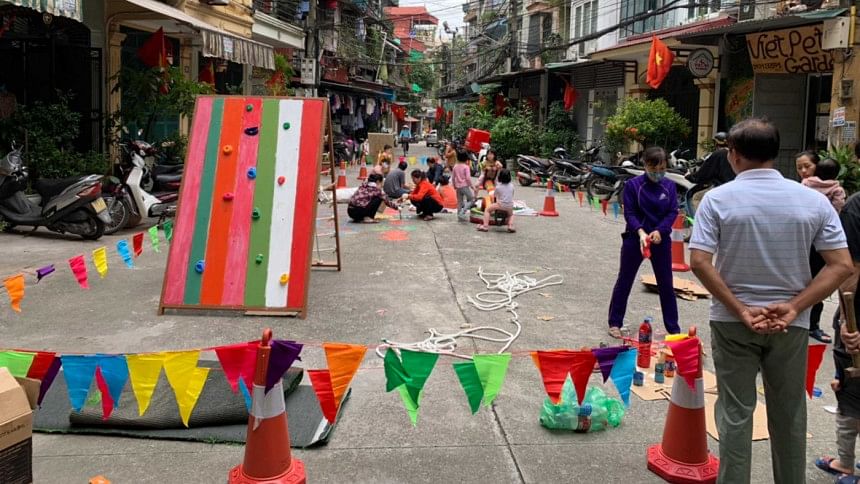Mobile Playground, Happy Children

Have you ever watched kittens, puppies, or other baby animals play? Running, chasing, jumping, nipping. Young goats scramble up a hill and push each other off. Colts bound joyously across open fields. They have fun, sure, but they also gain physical strength, agility, and various other skills necessary for survival.
What is essential for other animals is not optional for people. We need parks for recreation, socialising, exercise and play. We also need more porous surfaces and trees as Bangladesh bears the brunt of the climate crisis ever more in ensuing years. Ideally, then, the importance of green space would translate into prioritising parks and playgrounds throughout the city, and ensuring that they are accessible for all.
And yet, caught up in our busy lives, we seem to forget that play is not just for fun. Many parents seem not to realise that play is necessary. Many do not recognise that it is not healthy—physically, mentally or socially—for children to be shuttled about between school and tutoring, with no opportunity to run about and, well, be children.
As for those parents who do understand the importance, who live in a city, and who realise that active outdoor play has many advantages that playing with a smartphone does not, the question arises: "Where can my children play?" In the rush of development, modernisation, and with an influx of climate refugees, what open spaces are left in cities? How many schools or neighbourhoods have playgrounds? How many areas have usable parks?
We need to create many more such spaces in our cities. But we cannot afford to wait quietly. Children's development is being harmed by the absence of such spaces. The Covid-19 pandemic has only exacerbated the problem.
We need to understand that the term "public space" includes streets, roads, and footpaths. That the purpose of such spaces is not only for travel. That public space in cities is too valuable to surrender it all to the use of the automobile. All this shuttling about, here and there, back and forth, may serve some important purpose—though one can't help but wonder how much—but at least equally important is the need for children to play. And given that many streets are little used for many hours of the day, why not turn them temporarily into playgrounds?
Dhaka has, prior to Covid-19, experimented successfully with the concept of car-free streets. One side of Manik Mia Avenue was transformed, on the morning of first Friday every month, into a joyous celebration of life. Other such events were organised regularly in Mohammadpur and Uttara. Alas, they all stopped due to Covid-19 and have not resumed.
To fill in the gap, Work for a Better Bangladesh (WBB) Trust has begun a weekly event in West Dhanmondi. The mobile playground involves converting a quiet residential street into a temporary playground, particularly inviting to the youngest children—girls as well as boys—who have little other opportunity for outdoor play.
Two children show up hours in advance of the opening to help the WBB staff decorate the space. A teenage boy with Down Syndrome recites a prayer. Children pour out of the buildings and explore the play options: drawing, crafts, board games, skipping rope. Most of them don't know each other; they never have an opportunity to occupy and explore the streets. Parents are relieved and grateful. The entire scene is a combination of astonishing and ordinary: this is what our cities should provide, but so rarely do.
Sometimes, our big problems have surprisingly simple solutions. No place for children to play outdoors, for youth to play sports, to cycle, to skate? No place for adults to enjoy some time outside for exercise and socialising? Well, find a fairly quiet street and convert it, for a few hours a week, into a recreational space. And in the meantime, continue to remind our urban authorities that in addition to all our other needs in cities, we need access to existing playing fields. We need a lot more green space for climate resilience. We need green and open public space to help keep the population healthy—mentally and physically—and to ensure that children have the opportunity to develop their full potential as future contributors to our beloved Bangladesh.
Debra Efroymson is the executive director of the Institute of Wellbeing, Bangladesh, and author of "Beyond Apologies: Defining and Achieving an Economics of Wellbeing."

 For all latest news, follow The Daily Star's Google News channel.
For all latest news, follow The Daily Star's Google News channel. 



Comments